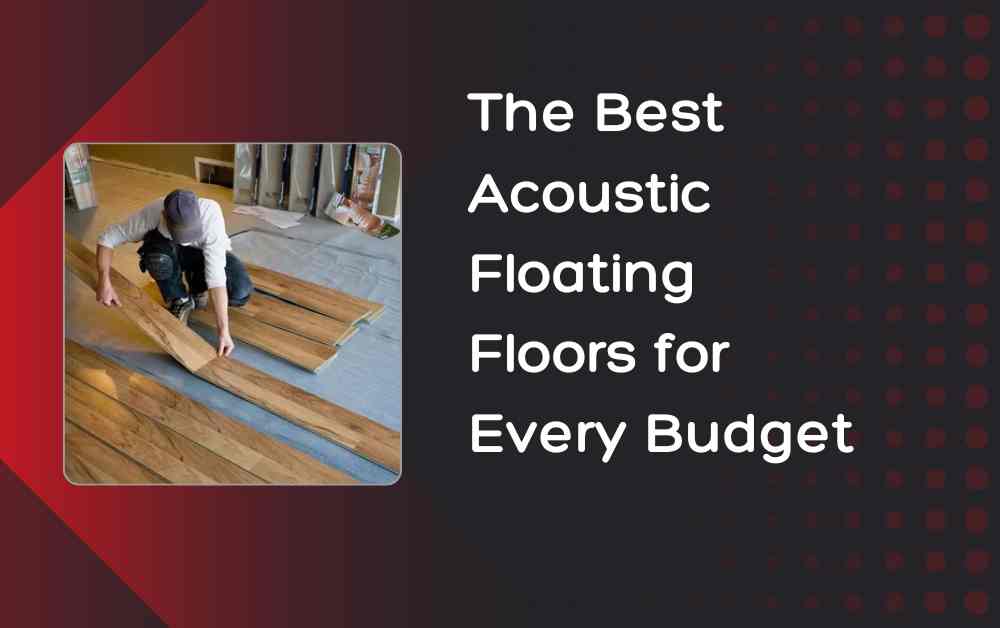Introduction to Acoustic Floating Floors
Acoustic floating floors are a fantastic solution for anyone looking to reduce noise in their home or office. These floors are designed to minimize sound transmission between different levels of a building. This can be particularly useful in apartment buildings, multi-story homes, and offices where noise from foot traffic, dropped objects, or even conversation can be a disturbance. The term “floating floor” refers to a type of flooring that does not need to be nailed or glued to the subfloor. Instead, the flooring “floats” above the subfloor, often using a system of interlocking planks or tiles. This method of installation makes it easier to install and often more cost-effective than traditional flooring options. Whether you are on a tight budget or looking for premium options, there is an acoustic floating floor to suit your needs.
NOTE : “Transform your space with the best soundproofing solution available! Explore our top-quality Acoustic floating floor UAE today and experience unparalleled noise reduction. Contact us now for a free consultation and take the first step towards a quieter, more peaceful environment.”
Why Choose Acoustic Floating Floors?
Choosing acoustic floating floors comes with several benefits beyond just noise reduction. One of the primary advantages is the ease of installation. Unlike traditional floors, which may require professional installation, many floating floors can be installed by a capable DIY enthusiast. This can save you a significant amount of money on labor costs. Additionally, these floors are versatile and can be installed over various types of subfloors, including concrete, plywood, and even existing flooring. Another significant benefit is the comfort underfoot. Many acoustic floating floors have a slight give, making them more comfortable to walk on for extended periods. This can be particularly beneficial in homes with children or elderly individuals who may be more susceptible to falls. Finally, acoustic floating floors are often easier to repair than traditional flooring. If a section of the floor gets damaged, you can typically replace just the affected planks or tiles rather than having to replace the entire floor.
Budget-Friendly Acoustic Floating Floors
If you are on a tight budget, there are still excellent acoustic floating floor options available. Laminate flooring is one of the most affordable options on the market. It is made from a high-density fiberboard core with a photographic layer on top that can mimic the appearance of wood, stone, or other materials. Laminate flooring is durable and easy to install, making it a popular choice for budget-conscious homeowners. Another cost-effective option is vinyl plank flooring. Like laminate, vinyl planks are easy to install and come in a variety of styles. They are also water-resistant, making them a good choice for areas like kitchens and bathrooms. Cork flooring is another budget-friendly option that offers good acoustic properties. Cork is a natural material that is soft underfoot and has excellent sound-absorbing qualities. While it may be slightly more expensive than laminate or vinyl, it is still an affordable option for those looking to reduce noise in their home.
Mid-Range Acoustic Floating Floors
For those with a bit more flexibility in their budget, mid-range acoustic floating floors offer a great balance of cost and quality. Engineered hardwood flooring is a popular choice in this category. It consists of a real wood veneer over a core of high-density fiberboard or plywood. This gives it the appearance of solid hardwood while being more stable and resistant to moisture. Engineered hardwood is available in a wide range of styles and finishes, allowing you to achieve the look you want without breaking the bank. Another excellent mid-range option is luxury vinyl tile (LVT). LVT is similar to vinyl plank flooring but is generally thicker and more durable. It often includes a built-in underlayment that enhances its acoustic properties. LVT can mimic the appearance of stone or ceramic tile, providing a high-end look at a more affordable price. Bamboo flooring is another option in this price range. Bamboo is a sustainable material that is harder than many types of hardwood, making it a durable choice for busy households. It also has good acoustic properties, helping to reduce noise levels in your home.
High-End Acoustic Floating Floors
If you have a larger budget and are looking for the best quality, high-end acoustic floating floors are the way to go. Solid hardwood flooring is the gold standard in this category. While it is more expensive than other options, it offers unparalleled beauty and durability. Solid hardwood floors can last for decades if properly maintained and can be refinished multiple times. They also have excellent acoustic properties, particularly when installed with an appropriate underlayment. Another high-end option is porcelain tile. Porcelain tile is incredibly durable and resistant to moisture, making it an excellent choice for areas like kitchens and bathrooms. It is also available in a wide range of styles, including options that mimic the appearance of natural stone or wood. When installed with a sound-absorbing underlayment, porcelain tile can significantly reduce noise levels in your home. For those who want the best of the best, natural stone flooring is the ultimate choice. While it is the most expensive option, natural stone offers unmatched beauty and durability. It also has excellent acoustic properties, particularly when paired with a high-quality underlayment.
Installation Tips for Acoustic Floating Floors
Proper installation is crucial for maximizing the acoustic benefits of your floating floor. The first step is to ensure that your subfloor is clean, dry, and level. Any imperfections in the subfloor can affect the performance of your floating floor. Next, you will need to choose an appropriate underlayment. The underlayment serves as a barrier between the subfloor and the floating floor, helping to absorb sound and provide a cushion underfoot. There are many different types of underlayments available, so be sure to choose one that is compatible with your flooring material. When installing the floor, be sure to leave a small gap around the edges of the room to allow for expansion. This gap can be covered with baseboards or molding for a finished look. Finally, take your time to ensure that each plank or tile is properly aligned and securely connected. This will help to prevent any gaps or uneven spots in your floor, ensuring a smooth and quiet surface.
Maintenance and Care for Acoustic Floating Floors
Maintaining your acoustic floating floors is essential for ensuring their longevity and performance. Regular cleaning is the first step in maintaining your floors. Sweep or vacuum your floors regularly to remove dirt and debris that can cause scratches. For deeper cleaning, use a damp mop with a mild cleaner that is safe for your flooring material. Be sure to avoid using excessive water, as this can damage certain types of flooring, such as laminate and hardwood. Protect your floors from scratches by using furniture pads under the legs of chairs and tables. Additionally, consider placing rugs or mats in high-traffic areas to reduce wear and tear. If your floor becomes damaged, address the issue as soon as possible to prevent further damage. Many floating floors allow you to replace individual planks or tiles, making repairs relatively easy. By following these maintenance tips, you can keep your acoustic floating floors looking and performing their best for years to come.
Conclusion: Finding the Right Acoustic Floating Floor for You
In conclusion, there are acoustic floating floors available to suit every budget and style preference. Whether you are looking for a budget-friendly option like laminate or vinyl, a mid-range choice like engineered hardwood or luxury vinyl tile, or a high-end option like solid hardwood or natural stone, there is a floor that will meet your needs. By considering factors such as cost, durability, and ease of installation, you can find the perfect acoustic floating floor for your home or office. Remember to follow proper installation and maintenance practices to ensure that your floors provide the maximum acoustic benefits and last for many years. With the right choice and care, your acoustic floating floors can help create a quieter, more comfortable living environment.
For more insightful articles related to this topic, feel free to visit relxnn









